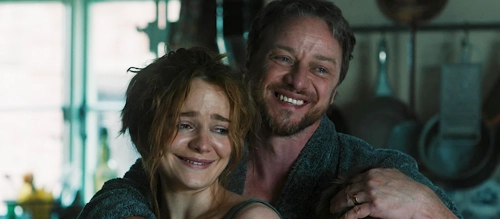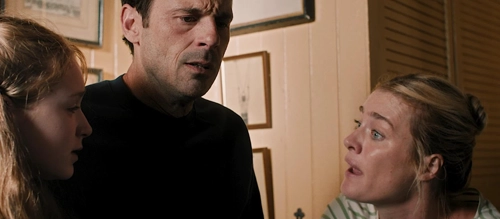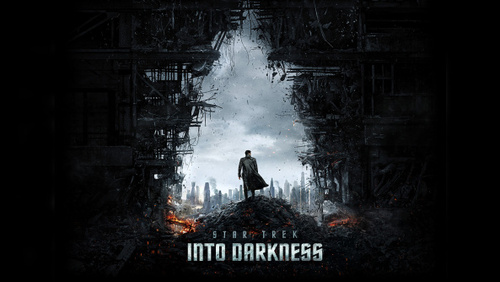
Speak No Evil (2024)
Director: James Watkins
Screenwriters: James Watkins, Christian Tafdrup, Mads Tafdrup
Starring: James McAvoy, Mackenzie Davis, Scoot McNairy, Aisling Franciosi, Alix West Lefler, Dan Hough, Kris Hitchen
Politeness is an unspoken agreement we all follow – a way to keep the peace, even when we’re uncomfortable. In American culture in particular, we are conditioned to remain pleasant through awkward moments, to say “yes” when we really mean “no,” and to endure discomfort to avoid being labelled rude or confrontational. This façade often allows uncomfortable situations to persist, as it masks the unease we choose not to confront. In Speak No Evil (2024), this delicate balance comes to a boiling point, where the mask of politeness shatters, and the true cost of silence reveals itself in devastating ways.
This American remake, arriving just two short years after the original Danish film, was met with some skepticism. Independent European films, particularly ones like Speak No Evil (2022), rarely make a significant splash in the U.S., and the original’s chilling suspense only found a niche audience. The remake seeks to introduce a broader American audience to the story, but in doing so risks losing some of the cultural nuance and intensity that defined the original. Fans of the 2022 version were wary, and the film’s marketing, especially its trailer, only heightened concerns. The trailer, which dominated theaters and social media throughout this summer (2024), was criticized for revealing way too much. While that backlash may be exaggerated, it is not entirely without reason. The movie thrives on ambiguity and tension, and for those who saw the trailer, some of the mystery may feel prematurely revealed.
What sets this remake apart is the strength of its cast – chiefly, James McAvoy, who delivers a mesmerizing performance as Paddy. McAvoy strikes a faultless balance between charisma and menace, drawing the audience in with a disarming charm before gradually revealing more sinister undertones. His portrayal here recalls elements of his work in Split (2017), but it’s far more unsettling due to its realism. Unlike Split, where McAvoy navigated a more fantastical premise, his menace in Speak No Evil is grounded in real-world plausibility. Mackenzie Davis also delivers an understated yet powerful performance as Louise, using subtle body language to convey a growing sense of dread that mirrors the film’s ever-present tension.
Visually, Speak No Evil excels in using its setting as a character in itself. The countryside home becomes more than just a backdrop; under the direction of James Watkins and the careful cinematography of Tim Maurice-Jones, the house takes on a dual role – both familiar and ominous, a sanctuary turned prison. The attention to detail extends to elements like the couple’s Tesla, a sleek but hollow emblem of their superficial eco-consciousness, amplifying the film’s exploration of appearances versus reality. Watkins, known for The Woman in Black (2013) and Eden Lake (2008), demonstrates his finest work in atmospheric tension here, surpassing his previous films in creating a deeply unsettling environment to place his characters into.

The film thrives on its carefully calibrated discomfort, allowing the characters to linger in situations that at first seem awkward but quickly shift into something far more sinister. Watkins is particularly adept at capturing the discomfort of social interactions – those small, almost imperceptible moments where something feels off, but it’s hard to pinpoint why. These interactions escalate, and before the characters (or the audience) fully realize it, they’re trapped in a scenario that is far more dangerous than it initially appeared. The escalating violation of boundaries and the characters’ mounting realization that they may already be too late to escape creates an almost unbearable sense of claustrophobia.
Unlike many mainstream horror films that rely heavily on jump scares, Speak No Evil opts for a more restrained approach. The film builds its tension through quiet moments of uneasiness, making the eventual confrontation between the two families all the more chilling. Each uncomfortable exchange feels heavier as the stakes rise, moving from minor social faux pas to acts of control and manipulation. This restrained approach allows us to become deeply invested in the characters’ increasingly fraught dynamics.
Part of the film’s uniqueness is its ability to explore societal and gender issues, particularly around toxic masculinity and family roles. The pressure on men to act as protectors is woven into the film’s fabric, forcing the male characters to confront their perceived failures in protecting their families. However, while the film raises intriguing questions about these dynamics, its handling of gender roles sometimes feels superficial. In attempting to tackle too many issues at once, the film occasionally blurs its focus, diluting the impact of its social commentary. Nevertheless, Watkins navigates these themes with enough precision to encourage us to reflect on the lengths we might go to preserve control and avoid conflict.
But was this remake necessary?
The original film was lauded for its cultural depth and unrelenting intensity, while the American version, which caters to a wider audience, loses some of that raw edge. It exchanges existential dread for a more chaotic, dramatic finale, which may disappoint those who appreciated the bleakness of the original.
Ultimately, Speak No Evil (2024) taps into anxieties about societal expectations, politeness, and the roles we assume in our families, forcing us to confront how far we would go to maintain the illusion of control. While it may not surpass the original, this remake holds its own as a chilling reflection on the cost of silence and the darker aspects of human interaction.
Score: 15/24
Written by Jake Fittipaldi
You can support Jake Fittipaldi in the following places:
Instagram: @jakefittipaldi
Letterboxd: /jakefittipaldi

